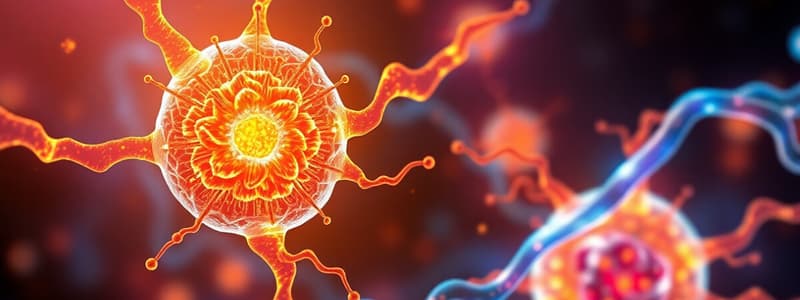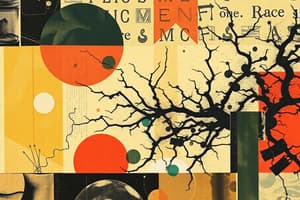Podcast
Questions and Answers
What is a primary function of Ca2+ ions in cell signaling?
What is a primary function of Ca2+ ions in cell signaling?
- They lead to the permanent activation of all signaling proteins.
- They only function in neurotransmitter release.
- They inhibit all forms of signaling.
- They act as a secondary messenger to mediate signaling pathways. (correct)
Which receptor type is primarily linked to the activation of adenylyl cyclase?
Which receptor type is primarily linked to the activation of adenylyl cyclase?
- Nuclear hormone receptors
- G-Protein Coupled Receptors (correct)
- Ionotropic receptors
- Receptor Tyrosine Kinases
What role do phosphatidylserine and diacylglycerol (DAG) play in cell signaling?
What role do phosphatidylserine and diacylglycerol (DAG) play in cell signaling?
- They initiate muscle contractions directly.
- They serve as secondary messengers that modulate protein kinase activity. (correct)
- They are involved in the digestion of nutrients.
- They function solely as structural components of cell membranes.
What is the significance of Ca2+ oscillations in signaling pathways?
What is the significance of Ca2+ oscillations in signaling pathways?
How do G-protein linked receptors contribute to neurotransmitter signaling in olfaction?
How do G-protein linked receptors contribute to neurotransmitter signaling in olfaction?
What is the primary function of CaM-kinase II in neuronal cells?
What is the primary function of CaM-kinase II in neuronal cells?
Which of the following statements about olfactory receptors is accurate?
Which of the following statements about olfactory receptors is accurate?
How do G-protein coupled receptors (GPCRs) regulate physiological tasks?
How do G-protein coupled receptors (GPCRs) regulate physiological tasks?
Which second messenger is NOT associated with G-protein signaling pathways?
Which second messenger is NOT associated with G-protein signaling pathways?
What process is mediated by the activation of olfactory receptors when an odorant is detected?
What process is mediated by the activation of olfactory receptors when an odorant is detected?
What role do RGS proteins play in G-protein signaling?
What role do RGS proteins play in G-protein signaling?
Which of the following accurately describes the role of Ca2+ in cellular signaling?
Which of the following accurately describes the role of Ca2+ in cellular signaling?
What is the primary function of the signal amplification mechanism in GPCR pathways?
What is the primary function of the signal amplification mechanism in GPCR pathways?
What role do intracellular signaling proteins play in signal amplification?
What role do intracellular signaling proteins play in signal amplification?
Which domain specifically binds phosphorylated tyrosine within signaling proteins?
Which domain specifically binds phosphorylated tyrosine within signaling proteins?
What is created during the clustering of receptors and signaling proteins?
What is created during the clustering of receptors and signaling proteins?
How do second messengers affect intracellular signaling?
How do second messengers affect intracellular signaling?
What is a characteristic of G-protein linked receptors in signal transduction?
What is a characteristic of G-protein linked receptors in signal transduction?
What is a key feature of calcium signaling in cellular responses?
What is a key feature of calcium signaling in cellular responses?
What type of neurotransmitter signaling is particularly relevant in olfaction?
What type of neurotransmitter signaling is particularly relevant in olfaction?
What do Ca2+ oscillations indicate in cellular signaling processes?
What do Ca2+ oscillations indicate in cellular signaling processes?
Flashcards
Cell-Cell Signaling
Cell-Cell Signaling
Ancient, varied communication between cells; crucial for different functions, cooperation, and understanding the cellular context.
G-Protein Coupled Receptors (GPCRs)
G-Protein Coupled Receptors (GPCRs)
Large family of receptors that use G-proteins to transmit signals.
Trimeric G Proteins
Trimeric G Proteins
Important actors in signal transduction, working with GPCRs.
Second Messengers
Second Messengers
Signup and view all the flashcards
Signaling Pathways
Signaling Pathways
Signup and view all the flashcards
CaM-kinase II activity
CaM-kinase II activity
Signup and view all the flashcards
Olfactory receptors
Olfactory receptors
Signup and view all the flashcards
Olfactory receptor cells
Olfactory receptor cells
Signup and view all the flashcards
G-protein-linked receptors
G-protein-linked receptors
Signup and view all the flashcards
Olfactory epithelium
Olfactory epithelium
Signup and view all the flashcards
Signal amplification
Signal amplification
Signup and view all the flashcards
G protein
G protein
Signup and view all the flashcards
Glomerulus
Glomerulus
Signup and view all the flashcards
Signal Response Specificity
Signal Response Specificity
Signup and view all the flashcards
Intracellular Context
Intracellular Context
Signup and view all the flashcards
Modular Interaction Domains
Modular Interaction Domains
Signup and view all the flashcards
Signaling Complex
Signaling Complex
Signup and view all the flashcards
Phase-Shift Transit
Phase-Shift Transit
Signup and view all the flashcards
Coincidence Detection
Coincidence Detection
Signup and view all the flashcards
Study Notes
Cell Signaling Overview
- Cell-cell signaling is ancient, varied, and cooperative. It's integral to cell context, second messengers, molecular switches, cascade amplification, and keeping/turning pathways off.
- There are over 1500 receptors in humans.
- Signaling molecules can be proteins, peptides, amino acids, nucleotides, steroids, retinoids, dissolved gases (like NO), light, touch, and heat. These are often released through exocytosis or transmembrane transport.
G-Protein Coupled Receptors (GPCRs)
- GPCRs are a large family of receptors, comprised of trimeric G proteins.
- They regulate the turning off of G proteins, adenylyl cyclase/cAMP, PKA, IP3, phospholipase C-β, Ca2+ mediated signaling, and CaM-Kinase. Olfaction is also related to GPCRs.
Bacterial Films
- K+ efflux changes transmembrane voltage and releases K+ ions in neighboring cells.
- Available glutamate and Yugo are involved in biofilm processes.
- B. subtilis is a pertinent example/species involved in bacterial films
cAMP in Dictyostelium discoideum
- Dictyostelium discoideum uses cAMP for fruiting body formation, spore germination, starvation, and aggregation.
- The signal transduction pathways used by Dictyostelium for chemotaxis and leukocyte migration to infection sites are conserved.
Origins of Signaling
- Cell signaling is ancient. Our current systems likely evolved from unicellular ancestors.
- Examples of signaling systems in unicellular organisms include those seen in S. cerevisiae, such as mating factor peptides.
Cell Signaling: Reception
- Receptors are located on the plasma membrane or inside the cell (intracellular receptors).
- Hydrophilic signals bind to cell-surface receptors.
- Hydrophobic signals bind to intracellular receptors.
Types of signaling
- Short range: Contact-dependent, immune system, etc.
- Long range: Synaptic neurotransmitters, endocrine hormones, etc.
- Autocrine: Signals target the same cell that released them.
- Paracrine: Signal targets neighboring cells.
- Endocrine: Signals travel through the bloodstream to distant targets.
Nitric Oxide
- Nitric oxide (NO gas) mediates smooth muscle relaxation.
- NO can increase blood flow by up to 200%, reducing blood pressure
- NO has a 5-10 sec half-life and is rapidly diffusible across membranes.
Steroid and Thyroid Hormones
- Steroid and thyroid hormones are small and hydrophobic, remaining in blood for hours or days.
- These hormones often bind to nuclear hormone receptors, which are receptors and effectors at the same time.
- Humans have approximately 48 nuclear hormone receptors.
Receptor Classification
- Receptors can be divided into Cell-surface receptors and Intracellular receptors.
Signal Transduction Pathways
- Speed of signal is important. Some pathways (e.g. enzyme activation) take less than a second to minutes, others, (e.g. transcriptional regulation) take minutes to hours.
- Some signals have a fast effect and some have a slow effect. Signals can have many different consequences, some fast and some slower.
- This is different from the speed at which the signal is received and interpreted by the cell.
GPCRs
- *G-protein-coupled receptors—*are a large family of receptors that span the plasma membrane seven times. They mediate many physiological tasks and are activated by various molecules like hormones, photons, neurotransmitters, peptides, derivatives of amino acids, nucleotides, and fatty acids.
- GPCRs are important in many pathological conditions and are targets for about 25-30% of drugs.
- GPCRs are important in many physiological processes (smell, taste, vision, immune response, etc.)
- GPCRs often use intracellular signaling proteins and second messengers.
G Proteins
- G proteins are functionally coupled receptors to enzyme and/or channel effectors.
- G proteins are molecular switches. Turning "on" and "off"
- G proteins can be grouped into 5 main groups.
Regulation of Signal Pathway Activation/Deactivation
- Pathways are regulated by the presence/absence of ligands to turn themselves on and off.
- Important for cell desensitization—can happen at all steps in signal transduction pathways
- Hedgehog pathway is shown as an example of how pathways can be tightly regulated.
Important Second Messengers
- cAMP is frequently produced by adenylyl cyclase. cAMP activates PKA.
- IP3 is usually produced by activation of phospholipase C. IP3 releases calcium from the endoplasmic reticulum
- DAG is produced with IP3, it stays in the membrane and may activate PKC.
- Calcium moves from the outside to the cytoplasm.
Important Signaling Proteins
Many proteins are involved in signal transduction, including:
- kinases,
- phosphatases,
- scaffolding proteins,
- G-proteins,
- transcription factors, and
- others.
Examples/Applications of Cellular Processes
- Cholera toxin, a bacterial toxin, locks Gs α-subunit in the active state, causing high levels of cAMP and resulting in dehydration.
- CFTR is critical for water movement in lungs and gut, and important for preventing bacterial growth. Mutations in CFTR can cause cystic fibrosis.
- Olfactory receptors (in the nasal epithelium) detect odorants, and this activates cAMP production.
Studying That Suits You
Use AI to generate personalized quizzes and flashcards to suit your learning preferences.




